Passive Optical Networks. We start by
- 格式:pdf
- 大小:466.65 KB
- 文档页数:4
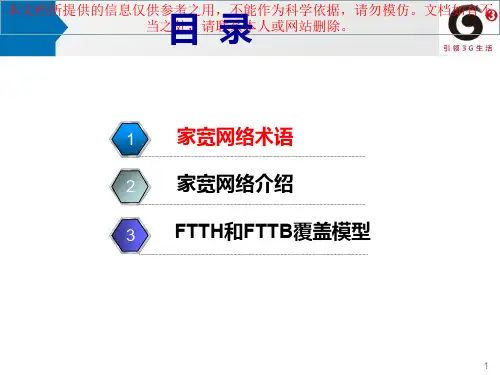
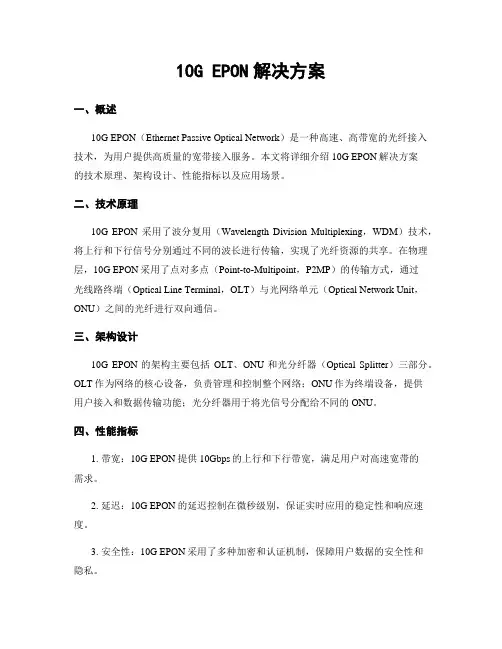
10G EPON解决方案一、概述10G EPON(Ethernet Passive Optical Network)是一种高速、高带宽的光纤接入技术,为用户提供高质量的宽带接入服务。
本文将详细介绍10G EPON解决方案的技术原理、架构设计、性能指标以及应用场景。
二、技术原理10G EPON采用了波分复用(Wavelength Division Multiplexing,WDM)技术,将上行和下行信号分别通过不同的波长进行传输,实现了光纤资源的共享。
在物理层,10G EPON采用了点对多点(Point-to-Multipoint,P2MP)的传输方式,通过光线路终端(Optical Line Terminal,OLT)与光网络单元(Optical Network Unit,ONU)之间的光纤进行双向通信。
三、架构设计10G EPON的架构主要包括OLT、ONU和光分纤器(Optical Splitter)三部分。
OLT作为网络的核心设备,负责管理和控制整个网络;ONU作为终端设备,提供用户接入和数据传输功能;光分纤器用于将光信号分配给不同的ONU。
四、性能指标1. 带宽:10G EPON提供10Gbps的上行和下行带宽,满足用户对高速宽带的需求。
2. 延迟:10G EPON的延迟控制在微秒级别,保证实时应用的稳定性和响应速度。
3. 安全性:10G EPON采用了多种加密和认证机制,保障用户数据的安全性和隐私。
4. 可靠性:10G EPON具备高可靠性和冗余性设计,确保网络的稳定运行。
五、应用场景1. 家庭宽带接入:10G EPON可以满足家庭用户对高速宽带的需求,支持多种终端设备的连接和高清视频流媒体的传输。
2. 企业网络接入:10G EPON提供高带宽、低延迟的网络接入服务,适用于企业的办公、数据传输和云计算等需求。
3. 公共服务网络:10G EPON可应用于公共服务领域,如教育、医疗和安防等,提供高速、稳定的网络连接。

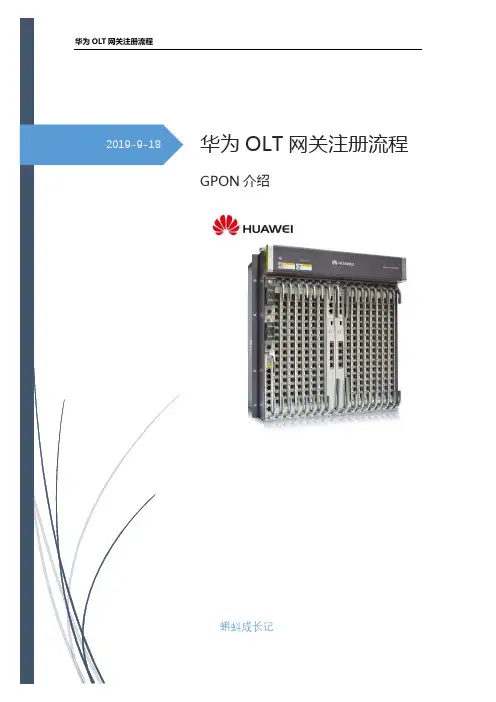
华为OLT网关注册流程2019-9-18 华为OLT网关注册流程GPON介绍蝌蚪成长记目录一、GPON介绍 (2)1.1 GPON简介 (2)1.2 GPON元素介绍 (3)(1)DBA (3)(2)T-CONT (4)(3)GEM port (4)(4)SERVICE-PORT (5)1.3 GPON元素间关系图 (5)1.4. GPON元素绑定关系 (6)二、华为OLT配置流程 (7)2.1. 配置环境 (7)2.2 OLT配置步骤及命令 (8)2.3 实验编址 (9)2.4 实验配置 (9)HW-SW5700交换机 (9)XG-SW交换机 (10)华为MA5800OLT配置流程 (10)一、GPON介绍1.1 GPON简介随着技术的发展,光纤变得“便宜又好用”,因此FTTx(FiberTo The X,光纤接入)作为新一代宽带解决方案被广泛应用,它为用户提供高带宽、全业务的接入平台。
同时,FTTH(FiberTo The Home,光纤到户)更是被称为是最理想的业务透明网络,是接入网发展的最终方式。
那么,FTTx是如何实现的呢?在多种方案中,PON(PassiveOptical Network,无源光纤网络)是最佳选择。
PON是一种应用于接入网,其主要结构如图1所示。
图1 PON结构组成从图1可以看出,PON(PassiveOptical Network)主要由光线路终端OLT(OpticalLine Terminal)、光网络单元ONU(OpticalNetwork Unit)和无源分光器POS(PassiveOptical Splitter)组成。
PON技术从20世纪90年开始发展,ITU从APON开始,经BPON,到现在的GPON;同时,IEEE也在以太网技术上发展了EPON技术。
目前用于宽带接入的PON技术主要有EPON 和GPON,两者采用不同标准。
由于本次使用的是GPON,因此后续内容都是围绕GPON进行说明。
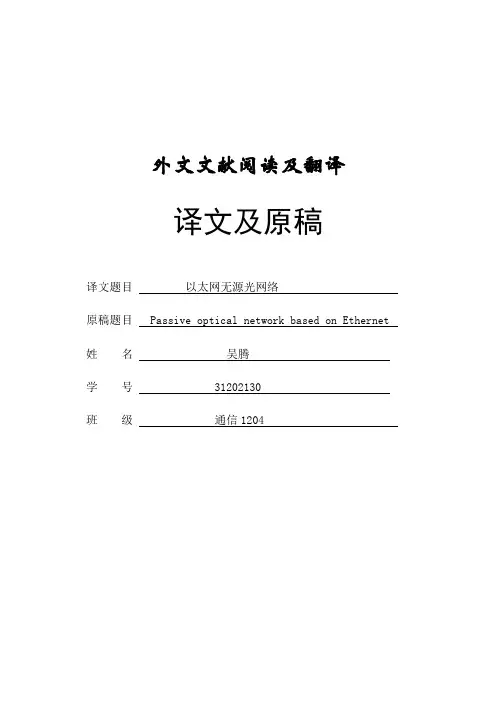
外文文献阅读及翻译译文及原稿译文题目以太网无源光网络原稿题目 Passive optical network based on Ethernet 姓名吴腾学号 31202130班级通信1204以太网无源光网络格伦·克雷默北京邮电大学出版社2007以太网无源光网络(Ethernet Passive Optical Network , EPON)是一种新型的光纤接入网技术,它采用点到多点结构、无源光纤传输,在以太网之上提供多种业务。
它在物理层采用了PON技术,在链路层使用以太网协议,利用PON的拓扑结构实现了以太网的接入。
因此,它综合了PON 技术和以太网技术的优点:低成本;高带宽;扩展性强,灵活快速的服务重组;与现有以太网的兼容性;方便的管理等等。
由于EPON的众多优点,它越来越受到人们的青睐,即将成为宽带接入网一种最有效的通信方法。
为了保证EPON网络能够稳定、高效、准确的运行,为EPON提供一个有效的网络管理系统显得尤为重要。
在网络管理领域,随着基于TCP/IP体系的网络管理技术的不断发展,SNMP已经成为事实上的标准。
基于SNMP的EPON网络管理系统是指采用SNMP管理协议框架,对EPONSNMP的介绍SNMP(简单网络管理协议)是一种基于TCP/IP的网络管理协议,它使用UDP作为传输层协议,能管理支持代理进程的网络设备。
SNMP主要包括SMI(管理信息结构)、MIB(管理信息库)和SNMP协议几部分。
SMI 给出了管理对象定义的一般框架。
MIB是设备所维护的全部被管理对象的结构集合。
SNMP协议包括SNMP操作、SNMP信息的格式以及如何在应用程序和设备SNMP采用代理/管理站模型进行网络管理。
SNMP有5种消息类型,分别为Get-Request、Get-Response、Get-Next-Request、Set-Request和Trap。
代理和管理站之间通过这几种消息报文进行相互通信,以获取网络设备的各种信息,从而控制网络设备的正常运行。
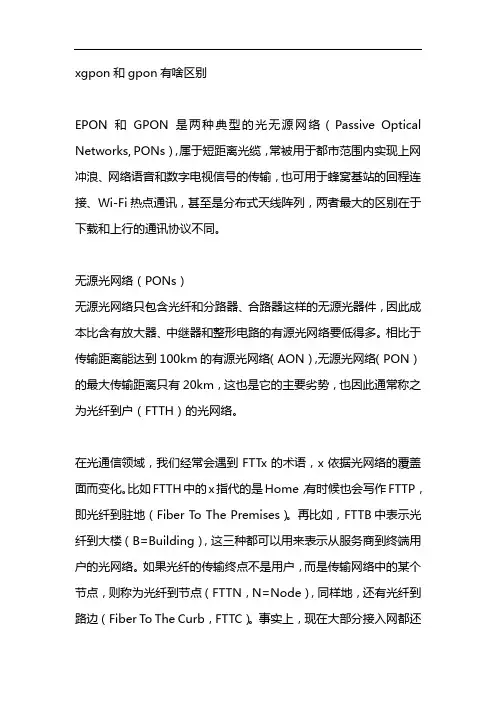
xgpon和gpon有啥区别EPON和GPON是两种典型的光无源网络(Passive Optical Networks, PONs),属于短距离光缆,常被用于都市范围内实现上网冲浪、网络语音和数字电视信号的传输,也可用于蜂窝基站的回程连接、Wi-Fi热点通讯,甚至是分布式天线阵列,两者最大的区别在于下载和上行的通讯协议不同。
无源光网络(PONs)无源光网络只包含光纤和分路器、合路器这样的无源光器件,因此成本比含有放大器、中继器和整形电路的有源光网络要低得多。
相比于传输距离能达到100km的有源光网络(AON),无源光网络(PON)的最大传输距离只有20km,这也是它的主要劣势,也因此通常称之为光纤到户(FTTH)的光网络。
在光通信领域,我们经常会遇到FTTx的术语,x依据光网络的覆盖面而变化。
比如FTTH中的x指代的是Home,有时候也会写作FTTP,即光纤到驻地(Fiber To The Premises)。
再比如,FTTB中表示光纤到大楼(B=Building),这三种都可以用来表示从服务商到终端用户的光网络。
如果光纤的传输终点不是用户,而是传输网络中的某个节点,则称为光纤到节点(FTTN,N=Node),同样地,还有光纤到路边(Fiber To The Curb,FTTC)。
事实上,现在大部分接入网都还没有光纤化,还是采用成本较低的非屏蔽双绞型铜线去实现光网络与终端用户设备连接的方式,比如常用的ADSL线。
典型的无源光网络分发机制采取“一对多”的形式,由某个光线路终端的中心点,通常是运营商的设备,对数字电视数据和网络服务进行分发,传输网络上的光分路器能将光信号分成不同频率的光信号,使得一根光纤连接的用户数从16到128不等。
光无源网络靠近终端用户的一侧称为光网络单元(OpticalNetwork Unit,ONU)或光网络终端(Optical Network Terminal,ONT),也就是我们常说的光猫,连接到用户的各种设备。
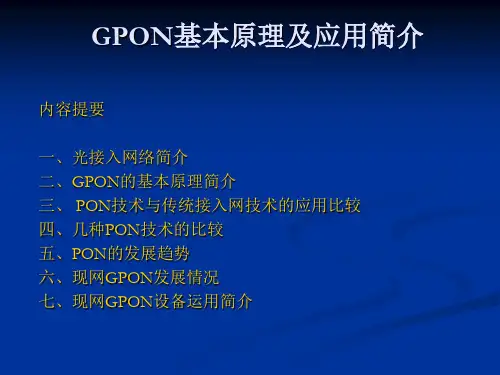
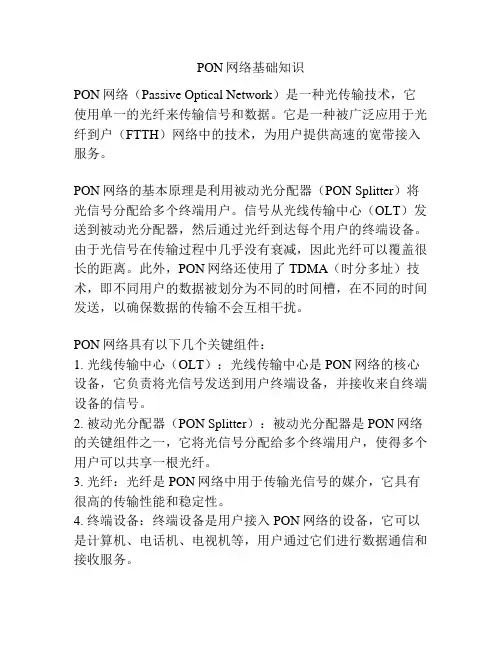
PON网络基础知识PON网络(Passive Optical Network)是一种光传输技术,它使用单一的光纤来传输信号和数据。
它是一种被广泛应用于光纤到户(FTTH)网络中的技术,为用户提供高速的宽带接入服务。
PON网络的基本原理是利用被动光分配器(PON Splitter)将光信号分配给多个终端用户。
信号从光线传输中心(OLT)发送到被动光分配器,然后通过光纤到达每个用户的终端设备。
由于光信号在传输过程中几乎没有衰减,因此光纤可以覆盖很长的距离。
此外,PON网络还使用了TDMA(时分多址)技术,即不同用户的数据被划分为不同的时间槽,在不同的时间发送,以确保数据的传输不会互相干扰。
PON网络具有以下几个关键组件:1. 光线传输中心(OLT):光线传输中心是PON网络的核心设备,它负责将光信号发送到用户终端设备,并接收来自终端设备的信号。
2. 被动光分配器(PON Splitter):被动光分配器是PON网络的关键组件之一,它将光信号分配给多个终端用户,使得多个用户可以共享一根光纤。
3. 光纤:光纤是PON网络中用于传输光信号的媒介,它具有很高的传输性能和稳定性。
4. 终端设备:终端设备是用户接入PON网络的设备,它可以是计算机、电话机、电视机等,用户通过它们进行数据通信和接收服务。
PON网络相对于传统的以太网有以下优势:1. 高速传输:PON网络可以提供高达100Mbps或更高的传输速度,远远高于传统的以太网。
2. 长传输距离:由于光信号在传输过程中几乎没有衰减,因此PON网络可以覆盖数十公里的距离。
3. 多用户共享:PON网络使用TDMA技术,可以将光信号分配给多个用户共享一根光纤,降低了网络成本和复杂性。
4. 高带宽:PON网络可以同时传输多种类型的信息,包括数据、语音和视频,满足用户对多种服务的需求。
PON网络在实际应用中具有广泛的用途,特别是在光纤到户(FTTH)网络中。
它可用于提供高速的宽带接入服务,满足用户对高速互联网的需求。
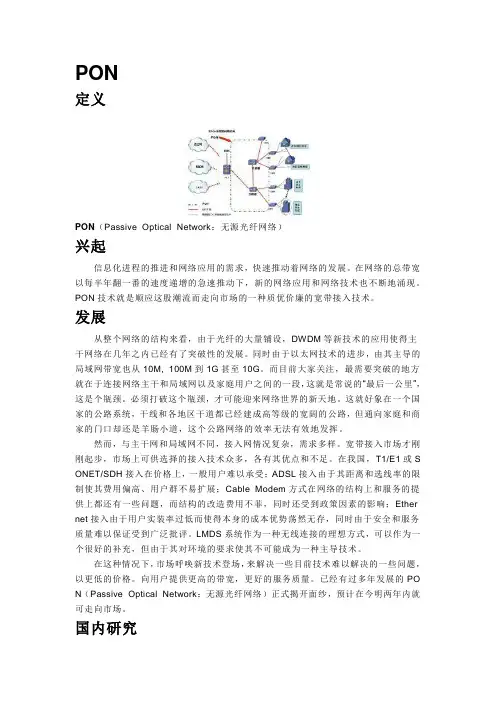
PON定义PON(Passive Optical Network:无源光纤网络)兴起信息化进程的推进和网络应用的需求,快速推动着网络的发展。
在网络的总带宽以每半年翻一番的速度递增的急速推动下,新的网络应用和网络技术也不断地涌现。
PON技术就是顺应这股潮流而走向市场的一种质优价廉的宽带接入技术。
发展从整个网络的结构来看,由于光纤的大量铺设,DWDM等新技术的应用使得主干网络在几年之内已经有了突破性的发展。
同时由于以太网技术的进步,由其主导的局域网带宽也从10M, 100M到1G甚至10G。
而目前大家关注,最需要突破的地方就在于连接网络主干和局域网以及家庭用户之间的一段,这就是常说的“最后一公里”,这是个瓶颈。
必须打破这个瓶颈,才可能迎来网络世界的新天地。
这就好象在一个国家的公路系统,干线和各地区干道都已经建成高等级的宽阔的公路,但通向家庭和商家的门口却还是羊肠小道,这个公路网络的效率无法有效地发挥。
然而,与主干网和局域网不同,接入网情况复杂,需求多样。
宽带接入市场才刚刚起步,市场上可供选择的接入技术众多,各有其优点和不足。
在我国,T1/E1或S ONET/SDH接入在价格上,一般用户难以承受;ADSL接入由于其距离和选线率的限制使其费用偏高、用户群不易扩展;Cable Modem方式在网络的结构上和服务的提供上都还有一些问题,而结构的改造费用不菲,同时还受到政策因素的影响;Ether net接入由于用户实装率过低而使得本身的成本优势荡然无存,同时由于安全和服务质量难以保证受到广泛批评。
LMDS系统作为一种无线连接的理想方式,可以作为一个很好的补充,但由于其对环境的要求使其不可能成为一种主导技术。
在这种情况下,市场呼唤新技术登场,来解决一些目前技术难以解决的一些问题,以更低的价格。
向用户提供更高的带宽,更好的服务质量。
已经有过多年发展的PO N(Passive Optical Network:无源光纤网络)正式揭开面纱,预计在今明两年内就可走向市场。

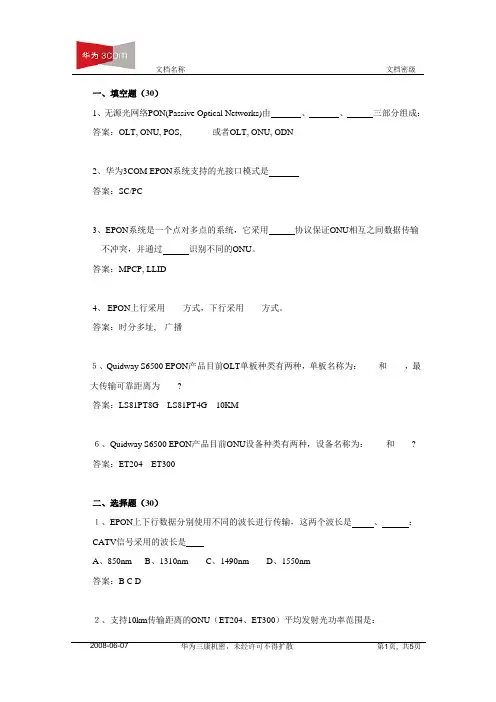
一、填空题(30)1、无源光网络PON(Passive Optical Networks)由、、三部分组成:答案:OLT, ONU, POS, 或者OLT, ONU, ODN2、华为3COM EPON系统支持的光接口模式是答案:SC/PC3、EPON系统是一个点对多点的系统,它采用协议保证ONU相互之间数据传输不冲突,并通过识别不同的ONU。
答案:MPCP, LLID4、EPON上行采用____方式,下行采用____方式。
答案:时分多址, 广播5、Quidway S6500 EPON产品目前OLT单板种类有两种,单板名称为:____和____,最大传输可靠距离为____?答案:LS81PT8G LS81PT4G 10KM6、Quidway S6500 EPON产品目前ONU设备种类有两种,设备名称为:____和____? 答案:ET204 ET300二、选择题(30)1、EPON上下行数据分别使用不同的波长进行传输,这两个波长是、:CATV信号采用的波长是A、850nmB、1310nmC、1490nmD、1550nm答案:B C D2、支持10km传输距离的ONU(ET204、ET300)平均发射光功率范围是:A、-3 ~+2 dBmB、-3 ~+4 dBmC、-1 ~+4 dBmD、+2 ~+7 dBm 答案: C3、华为3com的EPON系统,10km OLT/ONU光接口接收灵敏度是:A、≤-3dBmB、≤-12dBmC、≤-26dBmD、≤-30dBm答案: C4、ET204的用户端口类型是,ET300的用户端口类型是:A、4个100BASE-TB、4个10/100/1000BASE-TC、1个10/100/1000BASE-TD、4个10/100BASE-T答案:DC5、华为3com的EPON系统有哪几种分光器:A、1:2B、1:4C、1:8D、1:16E、1:32F、1:64答案:ABCDE6、以上六种分光器理论上光衰减值分别是:A、-1dBmB、-3dBmC、-6dBmD、-9dBmE、-12dBmF、-15dBmG、-18dBm答案:BCDEFG7.如下哪个命令是进行ET204的4个FE口pvid配置的配置命令?A:subport B:subport vlan-mode C: onuport D:feport答案:A8.进行ONU和MAC绑定使用如下哪个命令?A:bond mac B:bind mac C:bind onuid D:bind onuinfo答案:C9.对单个ET300升级,哪个命令正确。
华中科技大学硕士学位论文EPON系统中的ONU设计姓名:***申请学位级别:硕士专业:物理电子学指导教师:***20090519摘要近几年,中国光纤到户产业迅猛发展,在各种光纤接入技术中,EPON技术因其相关技术标准成熟更早、成本较低,在中国得到了大规模应用。
由于各个通信设备制造商使用有自定义OAM帧,而且不同EPON MAC芯片使用的OAM帧格式也不尽相同,这样不同厂家的OLT和ONU设备之间无法互通,对整个EPON产业发展不利。
中国电信为了解决这个问题,颁布了《中国电信EPON设备技术要求V2.0》,要求不同设备制造商研发的OLT和ONU可以互通。
我所在任务组的任务就是开发出支持互联互通的EPON设备,我的任务是设计EPON客户端设备ONU。
本文主要内容如下:绪论研究多种主流接入技术。
说明这些技术已经不满足目前应用需要并讨论本论文研究EPON的意义,为下一章进行EPON技术研究与ONU设计做铺垫。
第二章介绍EPON技术并给出了EPON系统总体方案设计。
首先对EPON技术、以及任务组总体设计方案进行介绍。
然后将ONU设计目标定为性价比较高的数据通信用ONU,具体有单住户型ONU和多住户型ONU两种,最后研究了这些ONU的设计方案。
第三章进行了单住户型ONU的设计与测试。
首先给出单住户型ONU的系统框图,并且研究其工作原理。
然后再分块描述单住户型ONU的各个子电路模块设计。
电路原理图设计完成后,介绍多层印制电路板(PCB)设计的注意事项,然后进行PCB设计与电路的焊接与调试。
最后是介绍以SmartBits 6000C为核心的测试环境,并对单住户型ONU进行基本功能验证与数据传输功能测试。
测试结果表明单住户型ONU功能良好。
第四章进行了单住户型ONU的设计与测试。
多住户型ONU在原理与结构上与单住户型差别不大,只是多出了交换芯片,用来增加以太网端口的数目。
本章结构与上一章相同,这里不叙述了。
第五章对全文进行总结,指出自己工作中的优点和不足。
GPON技术简介一、PON技术原理PON(Passive Optic Network)是一种采用点到多点(P2MP)结构的单纤、双向光接入网络,主要由OLT光线路终端、POS无源分光器、ONU光网络单元三部分组成。
为了分离同一根光纤上多个用户的来去方向的信号,PON采用WDM技术,下行采用1490nm波长,上行采用1310nm波长实现单纤双向数据传输。
CATV信号采用1550nm波长。
PON下行数据流采用广播技术,每个ONU都会接收到所有数据,ONU有选择的进行接收;上行数据流采用TDMA技术,OLT给每个ONU分配一定的授权时间窗口,ONU在OLT 分配的时间窗口内发送数据,占用上行带宽,实现上行带宽的动态分配。
DBA, Dynamically Bandwidth Assignment(动态带宽分配)是PON技术中的一项基本技术,通过DBA可以实现PON上行带宽的动态分配,提高带宽利用率。
DBA的基本原理:每个ONU 将需要发送的数据长度、优先级等信息上报OLT,OLT根据DBA算法计算出每个ONU的授权时间窗口并授权给ONU,ONU根据OLT的授权时间窗口发送数据占用上行带宽。
测距技术同样是PON技术中的一项基本技术,由于ONU距离OLT的实际距离是不一样的,所以ONU在OLT授权的时间窗口内发送的数据到达分光器时可能会产生冲突, 测距的主要作用就是为了避免这种冲突的产生。
测距的基本原理是OLT发送一个特定数据包给ONU,ONU收到后回传数据包,OLT通过收到回传数据包的时间和传输速率计算出到ONU的距离,然后给予一定的时延补偿,OLT通过调整每个ONU时延补偿的大小将不同距离的ONU拉到相同的逻辑距离,从而避免冲突的产生。
二、GPON的概念GPON(Gigabit-capable Passive Optical Networks),G比特无源光网络,标准在ITU-T G.984.X中定义,GPON采用专门的GEM(通用封装模式)帧格式,实现语音、数据、视频业务的传输。
EPON和GPON是两种典型的光无源网络(Passive Optical Networks, PONs),属于短距离光缆,常被用于都市范围内实现上网冲浪、网络语音和数字电视信号的传输,也可用于蜂窝基站的回程连接、Wi-Fi热点通讯,甚至是分布式天线阵列,两者最大的区别在于下载和上行的通讯协议不同。
无源光网络(PONs)无源光网络只包含光纤和分路器、合路器这样的无源光器件,因此成本比含有放大器、中继器和整形电路的有源光网络要低得多。
相比于传输距离能达到100km的有源光网络(AON),无源光网络(PON)的最大传输距离只有20km,这也是它的主要劣势,也因此通常称之为光纤到户(FTTH)的光网络。
在光通信领域,我们经常会遇到FTTx的术语,x依据光网络的覆盖面而变化。
比如FTTH中的x指代的是Home,有时候也会写作FTTP,即光纤到驻地(Fiber To The Premises)。
再比如,FTTB中表示光纤到大楼(B=Building),这三种都可以用来表示从服务商到终端用户的光网络。
如果光纤的传输终点不是用户,而是传输网络中的某个节点,则称为光纤到节点(FTTN,N=Node),同样地,还有光纤到路边(Fiber To The Curb,FTTC)。
事实上,现在大部分接入网都还没有光纤化,还是采用成本较低的非屏蔽双绞型铜线去实现光网络与终端用户设备连接的方式,比如常用的ADSL线。
典型的无源光网络分发机制采取“一对多”的形式,由某个光线路终端的中心点,通常是运营商的设备,对数字电视数据和网络服务进行分发,传输网络上的光分路器能将光信号分成不同频率的光信号,使得一根光纤连接的用户数从16到128不等。
光无源网络靠近终端用户的一侧称为光网络单元(OpticalNetwork Unit,ONU)或光网络终端(Optical Network Terminal,ONT),也就是我们常说的光猫,连接到用户的各种设备。
专利名称:PASSIVE OPTICAL NETWORK (PON)发明人:TSUJI, Akihiro申请号:EP09845783.1申请日:20090608公开号:EP2442496B1公开日:20140730专利内容由知识产权出版社提供摘要:An OLT 2 transmits an inquiry frame for checking a link and checking a data accumulation amount from an ONU 4. The ONU 4 returns an inquiry response frame as a response. When the ONU 4 detects a state in which an uplink traffic is not present, the ONU 4 writes to that effect on the response frame and transmits the response frame to the OLT 2. The OLT 2 monitors a downlink traffic. When the OLT 2 recognizes, based on a result of the monitoring or the inquiry response frame, a state in which the uplink or downlink traffic is not present, the OLT 2 instructs the ONU 4 to transition to a low power consumption mode. When the ONU 4 receives the instruction, the ONU 4 transitions a function unit corresponding to instruction content to the low power consumption mode. When the ONU 4 does not receive the inquiry frame for a predetermined time, the ONU 4 transitions function units other than a function unit that performs communication control to the low power consumption mode. The OLT 2 stops the transmission of the inquiry frame while the subscriber side apparatus transitions to the low power consumption mode.申请人:MITSUBISHI ELECTRIC CORP地址:JP国籍:JP代理机构:Pfenning, Meinig & Partner GbR 更多信息请下载全文后查看。
FTTH Standards, Deployments and Research IssuesDavid Gutierrez1, Kyeong Soo Kim2, Salvatore Rotolo2, Fu-Tai An1, Leonid G. Kazovsky1 1Photonics and Networking Research Laboratory, Stanford University2Advanced System Technology, STMicroelectronicsAbstractIn this paper we investigate the current status of Fiber-to-the-Home Passive Optical Networks. We start by reviewing the driving forces behind the push for broadband from the customer and service provider sides. PONs are currently preferred for new FTTH deployments for a variety of reasons; we review their standards, new technologies and deployment plans in the United States, Japan and Korea. We then describe SUCCESS-HPON, a next-generation optical access architecture that allows a smooth transition from TDM to WDM-PON. We finalize by summarizing what we believe are the main open research issues in this area. Keywords: FTTH, PON, WDM-PON.1. IntroductionThe driving forces for Fiber-to-the-Home/Curb/Node (FTTX) technologies in the telecom business can be better understood by briefly reviewing the history of broadband access. Traditionally, the two most common electronic communication services have been standard analog broadcast or cable TV and Plain Old Telephone Service (POTS). These two services were provided by separate infrastructures that coexisted peacefully for many years. The advent of the WWW created a marked increase in the demand of home data communication services. Starting about a decade or so ago, ILECs and MSOs started satisfying this demand in the form of Internet dial-up and DSL services the former, and HFC cable-modem services the latter, and thus started competing directly for customers.The bandwidth offered by DSL and HFC networks has been enough for users’ demands for now. However, the nature of the traffic that flows through the Internet is changing. New applications require higher bandwidths, support for constant-bit-rate (CBR) streaming media, symmetric data rates (e.g., for peer-to-peer file transfer), low delay for interactive applications and security. The Internet, originally designed to provide a best-effort service and make use of statistical multiplexing, will need many architectural upgrades in order to accommodate these new demands [1].One of the main current Internet issues is the last-mile bottleneck. While data rates in LANs, MANs and WANs range in the 100 Mbit/s - 10 Gbit/s, in broadband access they range in the 100 Kbit/s to a few Mbit/s. This bottleneck prevents the development of high-bandwidth interactive consumer services.ILECs, MSOs and others are all looking into ways to satisfy new broadband access demands. The Holy Grail is two-fold: First, have Fiber-to-the-Home (FTTH) connectivity to the customer premises; then, be able to provide voice, video and data, the so-called triple-play, over this single media. The ways to attain this Holy Grail are not at all clear, given intense competition, varying regulation and the uncertainty of customer take-rates [2]. New technologies, such as vDSL2 and WiMax, increase the array of possibilities, but also the uncertainty on the best way to proceed. It is clear, though, that none of these other technologies can provide the bandwidth that fiber does, making it the ideal medium for high-bandwidth applications and/or as the backhaul of wireless and DSL networks.Several technologies can be used for FTTX. The most straightforward, but most expensive, is through a point-to-point (P2P) network with active components from the Central Office (CO) to the premises. Limited deployments have used this technology (e.g. in Japan), but its costs are high: P2P networks need a separate fiber for each user and/or maintenance of the active elements in the distribution network.A good fraction of the installation and maintenance costs of access networks is due to active elements, when they are present. Because of this, Passive Optical Networks (PONs), those in which the distribution network has only passive elements, are currently viewed as the best alternative for FTTX. Most of the operating costs of the ILECs currently come from copper network maintenance; some argue that ILEC’s operating costs can actually be reduced by aggressively deploying FTTH [3].2. PONsPONs have a tree topology in order to maximize their coverage with minimum network splits, thus reducing optical power loss. This is important, since a passive distribution network has no amplifiers or regenerators.There are three standardized versions of PON: Ethernet PON (EPON), Broadband PON (BPON) and Gigabit PON (GPON). They all use two wavelengths, one for downstream and one for upstream data traffic. These wavelengths are time-shared among users, making them Time Division Multiplexed PONs (TDM-PONs). The total bandwidth available per user is thus limited by this time-sharing, especially if the connection is going to be used for CBR applications.A third wavelength can optionally be used for downstream analog video broadcasting (RF).Wavelength Division Multiplexing (WDM) can be used in PONs to increase the overall throughput. The cost is, however, usually much higher due to the use of tunable and wavelength-sensitive optical components. WDM-PONs are regarded as the next step after TDM-PONs, and are currently mostly in research phase. Korea Telecom (KT) has, however, announced the launch of a 100Mbit/s WDM-PON in 2005. Table 1 compares some of the key characteristics of PONs.EPON BPON GPON WDM-PONStandardIEEE802.3ahITUG.983ITU G.984 NoneFraming Ethernet ATM GFP/ATMProtocol IndependentMaximum Bandwidth 1 Gbit/s622Mbit/s2.488Gbit/s1-10 Gbit/sper channelUsers/PON 16 32 64 100’sAverage Bandwidth per User60Mbit/s20Mbit/s40 Mbit/s 1-10 Gbit/sVideo RF / IP RF RF / IP RF / IP EstimatedCostLowest Low Medium HighTable 1. PON Comparison.2.1. BPON and GPONIn 1995, North American operators joined efforts in the FSAN committee to draft standards for PONs. The results of their efforts were later standardized by the ITU in the G.983 and G.984 recommendations.The underlying transmission technology for the first set of standards is ATM cell-based. Because of this, they were at first named ATM PON (APON). The name was later changed to Broadband PON (BPON) to emphasize that they were not limited to ATM traffic. The BPON standards specify from the physical layer all the way up to OAM. The maximum speeds are 622 Mbit/s downstream and 155 Mbit/s upstream. Many manufacturers, including AFC, Alcatel, Calix, Motorola and Terawave, currently produce BPON products.Since the encapsulation of IP traffic in ATM cells creates a high overhead, or cell-tax, and in an effort to make a more flexible standard, GPON was developed. In GPON, the encapsulation is done using the Generic Framing Protocol, a flexible method for both bursty and CBR traffic. The GPON standards are in development, having the physical and transmission layers already well defined. Since the OAM and other higher-layers have not been defined yet in the standards, operators are reluctant to deploy them for now. Flexlight and Optical Solutions are some of the current manufacturers of GPON equipment.Deployments.Most of the North American operators have been involved in the development of the BPON and GPON standards. In their announced current and future FTTX deployments, they plan to use equipment based on these standards, because of their flexibility to support CBR applications and to adapt to their previous TDM-based infrastructure (e.g., T1 lines).Verizon, SBC and Bellsouth issued a joint request for FTTX proposals in late 2003. Bellsouth has opted for FTTC deployments with Gigabit Ethernet (GigE) feeder links instead of PONs; SBC has decided to go for B/GPON FTTH in new housing complexes, while deploying GigE FTTN+DSL in existing units. Verizon has decided to go for B/GPON FTTH in all cases. SBC expects to have 1M B/GPON FTTH and 17M FTTC+DSL customers by 2007. Verizon had 1M customers passed by the start of 2005, and expects to have 3M by year’s end, but the take-rate is not public.In Japan, NTT had been deploying BPON for some years and it actually had about 100k customers by 2004. However, NTT intends to shift its customers to EPON for reasons explained below.2.2. EPONA separate PON standardization effort was started based on the IEEE Ethernet protocol. The idea here was to make use of the huge base of low-cost Ethernet designs to allow for simpler, less expensive technology to be used in PONs. The downside is that Ethernet is mostly engineered for bursty data and not for CBR or TDM services. EPON was developed and formalized in the IEEE 802.3ah standards. The scope of these standards is limited to the physical transmission layer and thus the interoperability of the higher layers is not guaranteed. The maximum rate for EPON is nominally 1.25 Gbit/s, but due to the use of 8B/10B coding, it is effectively 1 Gbit/s.panies such as Alloptic, Centillium, Passavé and Teknovus produce EPON products, mostly for the Asian market. In Japan, both NTT and KDDI needed, due to intense competition, todeploy Gigabit FTTH services and could not wait for the GPON standards to be fully developed. In addition, providing broadcast video or POTS services is not a top priority for them due to regulation issues. Thus, they decided to shift to EPON for new and old customers. NTT has currently about 1M FTTX subscribers (including PON and P2P), which are going to be progressively switched to EPON.2.3. WDM-PONsWDM-PONs, as we mentioned above, use expensive components and, unlike long-haul networks, their cost is shared by only a few tens of users per network. However, they can provide Gbit/s rates to each user, which TDM-PONs cannot. The issue is how to do this in a cost-efficient manner.Deployments.In Korea, current vDSL systems provide 54 Mbit/s. The Korean government has a residential Internet connectivity rating system. In order to attain higher home connectivity ratings, KT has decided to go for 100 Mbit/s guaranteed per user with WDM-PONs, with a service scheduled to start later in 2005. The details of their architecture are not public. Figure 1. Relative costs and bandwidths of PONs.2.4. Hybrid TDM/WDM-PONsThe deployment of TDM-PONs has started. It is expected that by 2009 the number of users will be more than 10M worldwide [4]. Given this installed base and the increasing bandwidth demands, the issue will be how to migrate to WDM-PONs in a flexible and cost-efficient manner. Some Hybrid TDM/WDM-PONs have been proposed, including Samsung’s Hybrid PON [5] and Stanford’s SUCCESS-DWA [6] and SUCCESS-HPON [7]. In this paper we will discuss the latter.2.4.1. SUCCESS-HPONThe Stanford University aCCESS - Hybrid TDM / WDM-PON [7], or SUCCESS-HPON, architecture provides a smooth migration path from TDM to WDM-PONs. Figure 1 illustrates the place of SUCCESS-HPON among other PONs: it provides bandwidths comparable to regular WDM-PON, but at lower costs. This is achieved by (1) eliminating the need for lasers at the customer’s premises and (2) sharing tunable components at the CO.Figure 2. SUCCESS-HPON Architecture.In SUCCESS-HPON (Figure 2), the need for fixed or tunable lasers at the customer’s WDM Optical Network Units (ONUs) is eliminated by sending a continuous wave (CW) from the CO in which to modulate the upstream data. Avoiding the need of lasers, especially tunable ones, makes the ONUs considerably less expensive. There are several options for modulating the CWs at the ONUs. We propose to use Semiconductor Optical Amplifiers (SOAs), under the assumption that their potential integration with the electronics will decrease costs further.Tunable lasers and receivers at the CO are shared by all the network users for both downstream and upstream data traffic. This allows decreasing the total amount of components needed. This approach is scalable, since the number of components can be gradually increased as new customers join the network. Sharing these components is not easy; in order to do so effectively, innovative scheduling algorithms were developed [8].3. Open Research IssuesIn FTTX PONs, issues similar to those that arise in other networks, such as QoS, fairness, security and reliability, are present. Beyond these issues, however, there are some that are particular to access networks.TDM-PONs. The EPON standards specify only the network’s physical layer; the algorithms and protocols used to assign bandwidth to the users, ensuring fairness and QoS, are left open to the implementer. Considerable work has gone into developing Dynamic Bandwidth Allocation algorithmsBandwidth per User [Mbit/s] 101001000for this. A separate issue is how to provide open access for multiple ISPs to share the same fiber infrastructure when the local legislation requires it.Large-scale IP Video Networks.As discussed above, some service providers plan to deploy large-scale IP video networks to provide HDTV and VoD services. Even though this has been done in limited-size trials, the concept of a national IP video network is new and challenging. Some have suggested that the ideal situation is a combination of analog and IP video [9] (this also depends on legislation and copyright issues). Some of the technical difficulties lie in the deployment of scalable multicasting protocols, mapping multicast groups to conventional video channels and the development of inexpensive integrated set-top boxes.Integrated ONU / Wireless Base Station / Home Gateway / DSLAM. The integration of various components provides an opportunity to develop combined scheduling algorithms and MAC protocols that take into account multiple interfaces and users to optimize performance. Research on architectures, protocols and algorithms for such an integrated unit will be very valuable.Hybrid TDM/WDM-PON Architectures.To provide a smooth transition from TDM to WDM, the proposed network architectures will most likely need to efficiently share expensive tunable components. In the case of SUCCESS-HPON, by sharing the most expensive components, the overall cost of the network decreased; however, this increased the computational complexity of the system. This tradeoff between number of components and computational complexity is an issue of further research.WDM-PON.Research that lowers the cost of devices that are passive and WDM functional (e.g., athermal AWGs) and that facilitates the integration of optics with electronics (e.g., SOAs in an ONU) is very important. As in the case of Hybrid TDM/WDM PONs, how to select which devices to share and how to share them with fast scheduling algorithms is also a matter of further research.4. Concluding RemarksThere are many possible approaches for FTTX, in terms of technologies used, fiber reach and services provided; each country also has a particular legislation that affects the best local choices. This variety of approaches and the uncertainty of customer take-rates make it difficult for U.S. service providers to promptly commit to invest in large-scale deployments, slowing down FTTX penetration. However, it is acknowledged that given the bandwidth limitations of DSL and wireless solutions, fiber optic access will probably become commonplace, even if it takes longer than expected.Once the bandwidth demands exceed the capacity of TDM-PONs, there will be a need to move to WDM-PONs. We have discussed the proposed SUCCESS-HPON architecture, which provides a smooth transition path from TDM to WDM-PON in a scalable and cost-efficient manner.There are still many open research issues in both TDM and WDM-PONs, ranging from devices and systems integration to scheduling algorithms and communication protocols. These issues, added to the increasing residential bandwidth demands and competition among service providers, create a fertile ground for further research work with an industry impact.AcknowledgementsThe authors would like to thank STMicroelectronics, Stanford’s SNRC F/M/A program and OIDA’s PTAP program for their support.5. References[1] V.G. Cerf, “On the Evolution of InternetTechnologies”, IEEE Proceedings, Sep. 2004. [2] N.J. Frigo et al, “A View of Fiber to the HomeEconomics”, IEEE Comm. Mag., Aug. 2004. [3] “FTTP: Revolutionizing the Bells’ TelecomNetworks”, Bernstein Research - TelcordiaTechnologies Report, May 2004.[4] “PON IC Opportunities Expand as MarketRamps”, RHK Report, June 2004.[5] D.J. Shin et al, “ Hybrid WDM/TDM-PON withwavelength-selection-free transmitters”,IEEE/OSA JLT, Jan. 2005.[6] Y.-L. Hsueh et al, “SUCCESS-DWA: a highlyscalable and cost-effective optical accessnetwork”, IEEE Comm. Mag., Aug. 2004. [7] F.-T. An et al, “SUCCESS: A next-generationhybrid WDM/TDM optical access networkarchitecture,” IEEE/OSA JLT, Nov. 2004[8] K.S. Kim et al, “Design and performanceanalysis of scheduling algorithms for WDM-PON under SUCCESS-HPON architecture,” Toappear in IEEE/OSA JLT.[9] F. Wiener, “Examining Video Architectureswhich Optimize the Network Infrastructure forVideo Delivery over DSL and PON”,Proceedings of OFC, NTuB2, March 2005.。